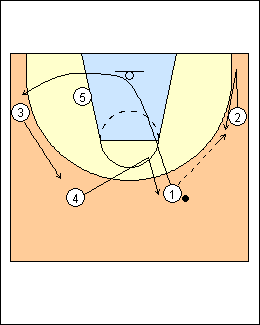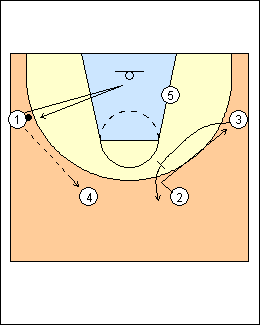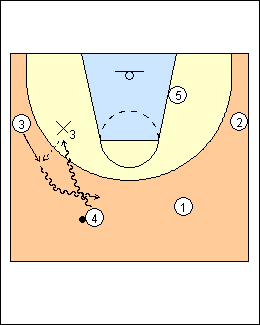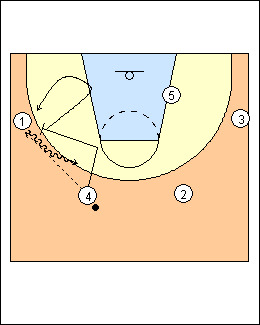4-out 1-in motion summary
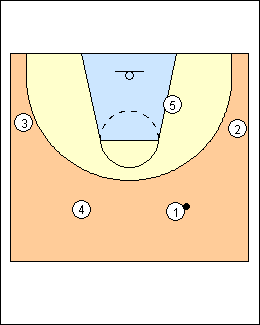 | 1 See Offence - 4-out 1-in motion for more diagrams and notes. Starting with basics (coachesclipboard.ca), this is a structured, step-wise approach to 4-out 1-in motion. Steps can be added in any order, they do not conflict with other steps, and there are progressions within steps. For "purer" motion, every passer would basket cut, corner cut, screen away, ballscreen, or go get a handback, but options for other players would still be limited or programmed to avoid chaos. 1) low-post movement 2) basket cut 3) backcut 4) screen away 5) passer flarescreen 6) weakside flarescreen 7) dribble-at 8) dribble loop 9) ballscreen with 4 10) handback 11) backscreen with 5 12) flarescreen with 5 13) up-and-down screen with 5 14) ballscreen with 5 15) perimeter backscreen on a skip pass 16) corner cut Keys - ball and receiver should arrive at the same time - when a spot is vacated, fill it - every passer is a cutter first, stepping towards the pass and reading whether to basket cut or screen - cut to the front of the rim with speed - space out then space up - when you get the ball, get into triple threat and hold for at least a one-count to read the cutter. For a complete motion offence, you also need rules on dribble penetration and post touches, see Tactics - 4-out 1-in drive and kick, and Passing into the low post. |
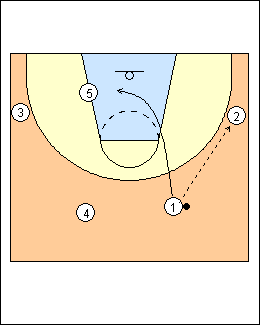 | 2 1) Low-post movement a) Use an open post to promote dribble-drive action, low-post 5 cleans up or relocates to the other side when a dribbler comes towards him (see Walberg dribble-drive). b) For a more pro-active role, 5 can make block-to-block ball cuts, but usually limited to once or twice per possession. 5 faces in when the ball is at the top or weakside wing, posts up when the ball goes to the ballside wing. Perimeter players follow normal cutting rules, but don't cut in front of a ballside post. Here 1 could cross-screen for weakside 5. See Bauer 4-out 1-in motion for progressions (e.g., duck-ins), and options on a pass to the low-post. Variations for 5 - always relocate opposite the ball - stay on one side - post directly between the ball and the basket - relocate opposite screening action - allow one cut from the perimeter before coming to the ball unless already ballside |
 | 5 4) Screen away a) On a swing to swing pass, the passer downscreens for the weakside wing, fist in the air and back to the ball. 3 looks to slip the screen and cut to the basket if open. 1 drags the arc by moving along the 3-point line towards the baseline then comes off the downscreen. 1 curls the screen, or will back-cut (reject the screen) if his defender goes over the screen early. 3 cuts back to the ball to fill the swing spot (hands ready for a pass and shot), 1 spaces back to the wing. Progressions b) allow other reads and cuts, especially if the screener is a non-shooter, i.e., the cutter elbow curls, bumps and fades, or straight (pop) cuts c) 3 can pass to 1 and screen away for 4 d) 3 can pass to 1, basket cut and screen away for weakside 5 e) 3 downscreens for 1, or 1 flarescreens for 3 (see Passer flarescreen). Jamie Dixon - curl and screen is an option, 1 curls the screen then screens for 3, a shooter. Bob Huggins - if defenders switch, 3 can slip the screen or 1 can make a switch cut - curl around the screen and screen for 3, who curls and 1 comes back to the ball. Have shooters screen for non-shooters, non-shooters backcut, they don't screen. (Option - non-shooters can screen for shooters, the cutter comes to the ball and the screener second cuts to the basket. A switch cut can help get the cutter open even if the defence doesn't switch.) See Tactics - Dave Smart using downscreens, Fast breaks - Florida 2005, and Offence - 4-out 1-in situations.  |
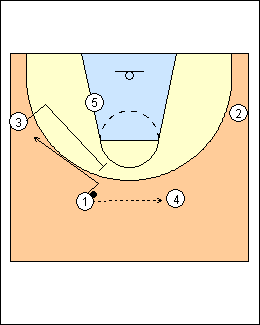 | 6 |
 | 9 |
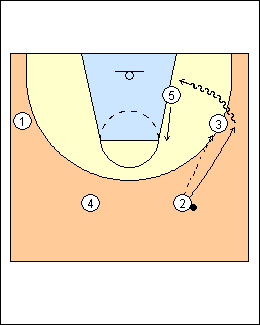 | 11 |
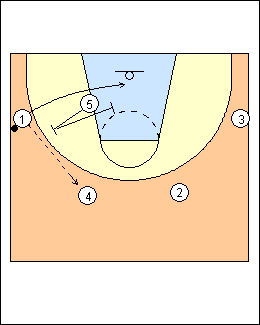 | 12 |
 | 13 Progressions b) Ballside 5 can backscreen if the wing is overplayed with the ball at the swing spot (or flash to the high post for a blind pig). |
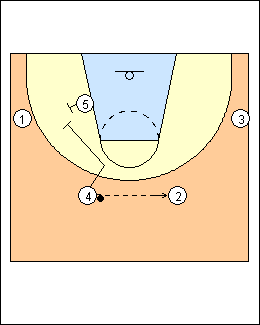 | 14 c) Ballside 5 backscreens for the wing on a swing to swing pass. 1 can use 4's diagonal screen or the backscreen from 5 (Jamie Dixon, Barker triangle offence), who then re-screens. |
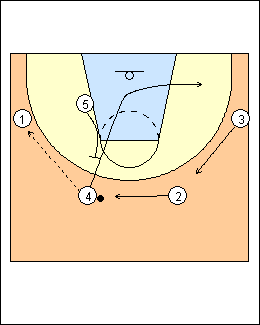 | 15 |
 | 17 b) Dribble-up flarescreen 2 has passed to 1 and cut to the basket, 1 dribbles up from the wing to the empty slot and passes to 3, at the same time 5 steps out of the post, follows the dribbler and sets a quick flarescreen as 1 passes. 3 would fill the swing spot on the dribble or after passing to 1. Option - 5 steps out as a ball reversal option, then dives inside on a catch and pass to 1. See Quick hitters - Dribble up to flarescreen, and C (double flare).  |
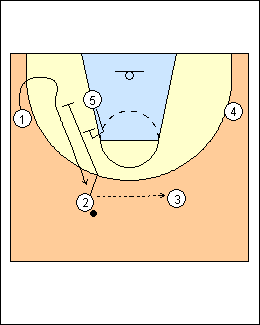 | 18 13) Up-and-down screen with 5 When 5 sees a downscreen on his side of the floor, he can go up the lane to set a second screen for the cutter. See the North Carolina fast break and Gonzaga offence.  |
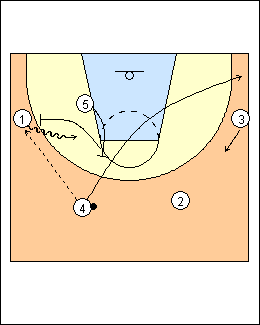 | 19 |
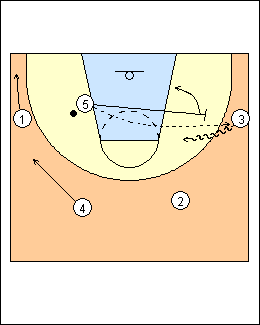 | 20 b) 5 can pass and follow to ballscreen. Here 5 has the ball at the low post, fans opposite to 3, follows to ballscreen, and can set a flat (butt) screen so that 3 can go either way (see Bill Self ballscreen offence and Florida 2006 fast break). Options - 4 dives weakside on the ballscreen - don't ballscreen on a pass out to 4. John David Jackson - if you have an undersized big, teach him how to make a dribble-out hand-off on the strongside wing. |
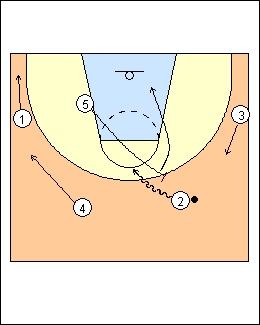 | 21 c) Spread fist 5 can come up to ballscreen for a swing ballhandler. 4 and 1 space away, 3 fills behind the screen. The ballscreen can be flat or angled. See Van Gundy shake ballscreen, Fast breaks - Versoix specials.  |
 | 22 15) Perimeter backscreen on a skip pass On a skip pass from 1 to 2 (wing to swing), 1 can basket cut then backscreen for 2 on a pass to 3 or 4. 5 backscreens for 1 if on the same side. See the Larry Brown secondary break.  |
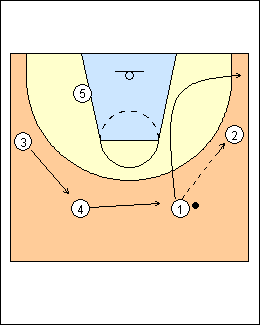 | 23 16) Corner cut On a swing-to-wing pass, the passer can basket cut, or corner cut if the wing player is high enough. Then always fill four perimeter spots, but not necessarily the swing and wing positions. Progression - the passer can corner cut on a swing to swing pass, the wing player moves up to make space as needed. Rick Majerus - Naked post - the corner cut by 1 isolates 5 on his side of the floor with no attacker on the wing. A corner cut can set up a shuffle cut and/or stagger screen, e.g. see Argentina flex. See Georgia Tech 4-out 1-in motion, and Walberg dribble-drive motion.  |
 | 24 Combining steps and progressions from above, an example of motion rules would be: - with the ball, attack the basket, pass fake, pass, or dribble-at for a hand-off, backcut, or to turn the corner - after passing, basket cut, corner cut, screen away, ballscreen, or go get a handback - one pass away from the ball, backcut if overplayed or on a pass fake - other players without the ball fill cut as needed on a basket cut or backcut - there are no ball flashes from the weakside - 5 starts weakside, cleans ups and relocates - if ballside, 5 can backscreen for a wing who is overplayed, ballscreen if the wing gets the ball, or backscreen if the wing passes. These general rules can be refined, e.g., 1-2-3 can pass and go for a handback, 4 can pass and go to ballscreen. Against pressure, use pass fakes, backcuts, dribble-ats, backscreens, blind pigs, and dribble entries (loop), also get the ball inside, and drive the basket. Some motion offences emphasize cutting (e.g., Petitgoue Iowa), others emphasize screens away from the ball (Petitgoue Pick), and this can be a useful teaching progression (also see Paul Hewitt 3 on 3).  |
This page was made with Basketball playbook from Jes-Soft
